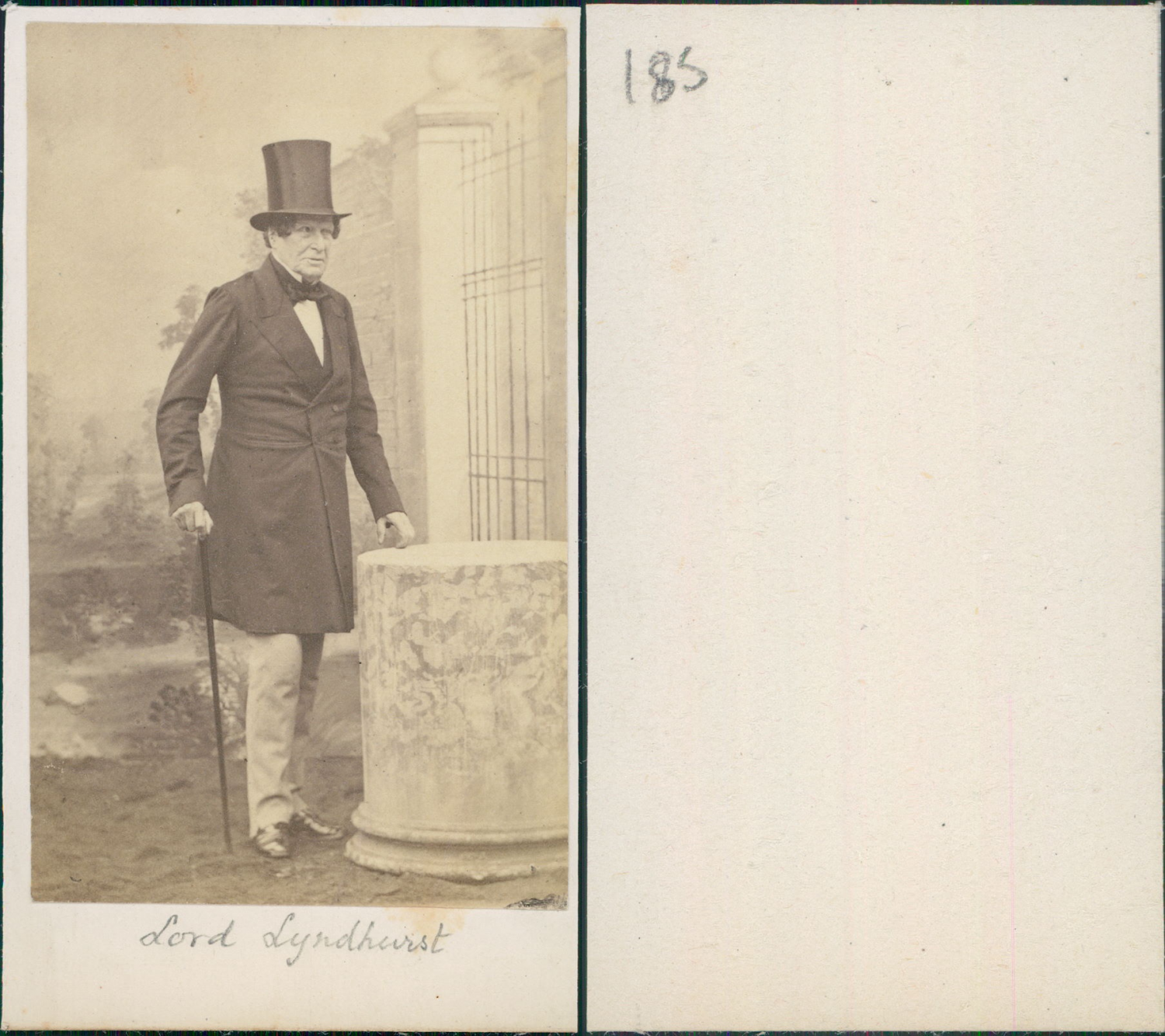Lord Lyndhurst, John Singleton Copley, 1st Baron Lyndhurst
Catégorie : CDV > portraits > Hommes politiquesAnnée : Circa 1870
Type : CDV, tirage albuminé, 6 x 10.5 cm, vintage albumen print
Format (cm): 6,5x10,5
vintage CDV albumen carte de visite, John Singleton Copley, 1st Baron Lyndhurst PC KS FRS (21 May 1772 – 12 October 1863), was a British lawyer and politician. He was three times Lord Chancellor of Great Britain.
Lyndhurst was born at Boston, Massachusetts, the son of painter John Singleton Copley and his wife Susanna Farnham (née Clarke), and was educated at a private school and Trinity College, Cambridge[1] where he graduated as second wrangler.
Political and legal career[edit]
Called to the bar at Lincolns Inn in 1804, he gained a considerable practice. He was appointed a serjeant-at-law on 6 July 1813. In 1817 he was one of the counsel for Dr J. Watson, tried for his share in the Spa Fields riots. Lyndhurst's performance attracted the attention of Lord Castlereagh and other Tory leaders, and he entered parliament as member for Yarmouth in the Isle of Wight. He afterwards sat for Ashburton (1818–1826) and for Cambridge University (1826–1827).
In December 1818, Copley was made King's Serjeant and Chief Justice of Chester. He became Solicitor General on 24 July 1819 and was knighted in October, became Attorney General in 1824, Master of the Rolls in 1826 and Lord Chancellor in 1827. On his appointment to the latter post he was raised to the peerage as Baron Lyndhurst, of Lyndhurst in the County of Southampton.[2] As solicitor-general he took a prominent part in the trial of Queen Caroline and was opposed to the Liberal measures which marked the end of the reign of George IV and the beginning of that of William IV. He was Lord Chief Baron of the Exchequer from 1831 to 1834. During the Melbourne government from 1835 to 1841 he figured conspicuously as an obstructionist in the House of Lords. His former adversary Lord Brougham, disgusted at his treatment by the Whig leaders, soon became his most powerful ally in opposition. Lyndhurst held the chancellorship from 1827–1830, 1834–1835, and 1841–1846. As he was in regard to Catholic emancipation, so in the agitation against the Corn Laws, he opposed reform until Peel, his chief, gave the signal for concession.
John Copley, 1st Baron Lyndhurst in the late 1850s.
After 1846 and the disintegration of the Tory party over Peel's adoption of free trade, Lord Lyndhurst did not attend parliament sessions as often, but he continued to take a lively interest in public affairs and to make speeches. His address to the House of Lords on 19 June 1854, on the war with Russia, made a sensation in Europe, and throughout the Crimean War he was a strong advocate of the energetic prosecution of hostilities. In 1859 he denounced Napoleon III. His last speech was delivered in the House of Lords at the age of eighty-nine.
Family[edit]
In 1819 Lord Lyndhurst married Sarah, a daughter of Charles Brunsden and widow of Lieutenant-Colonel Charles Thomas, who was killed at Waterloo. She died in 1834, and three years later, in August 1837, he married secondly Georgiana Goldsmith (1807–1901), daughter of writer Lewis Goldsmith, of Paris. They had one daughter, Georgiana Susan Copley, who married Sir Charles Du Cane, Governor of Tasmania.[3]
Since his second wife came from a family of Jewish origins, it may be her influence which led Lyndhurst to support the Jewish Emancipation of 1858, when the law which had restricted the Parliamentary oath of office to Christians was changed, leading to the admission of Jews into parliament. Lyndhurst also advocated women's rights in questions of divorce.
He died in London on 12 October 1863; as he left no son, his peerage became extinct. Lady Lyndhurst died in London 22 December 1901, aged 94.[3]
Articles connexes qui peuvent vous intéresser
Informations complémentaires relatives à la vente
Toutes les photographies vendues sur ce site sont des tirages originaux d'époques, sauf indications contraires.
Nous acceptons les retours sans conditions.
Nous expédions dans le monde entier via DHL, avec ou sans assurance, suivant la valeur.
Nous sommes acheteurs de collections complètes, si vous avez quelque chose à vendre, contactez-nous au 00 33 6 09 75 86 57 ou bien par mail à tartarin.photo@gmail.com
Concernant nos photochromes vintage, merci de lire: http://www.loc.gov/pictures/collection/pgz/process.html
All photographs sold on this site are vintage original prints, unless otherwise indicated.
We accept returns without conditions. We can ship free of charge Worlwide, with or without insurance, according to the value. We are buyers of complete collections, if you have something to sell, please contact us at 00 33 6 09 75 86 57 or by mail to tartarin.photo@gmail.com
Alle Fotos auf dieser Website verkauft Original-Abzüge von Perioden, sofern nicht anders angegeben.
Wir nehmen Rückkehr ohne Auflagen.
Wir senden frei von der Welt, mit oder ohne Versicherung, je nach dem Wert.
Concerning our vintage photochrom, please refere to: http://www.loc.gov/pictures/collection/pgz/process.html
[LR-1623407299]
